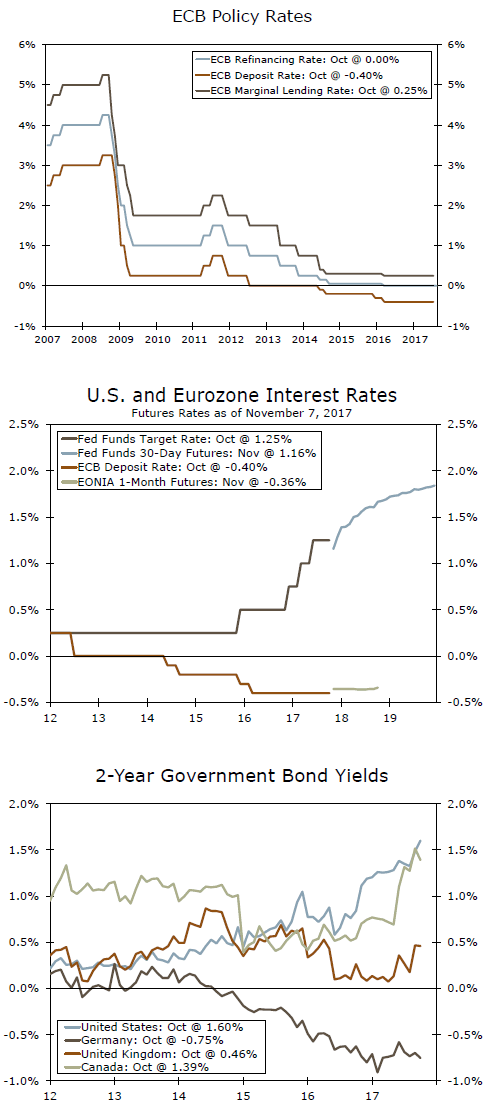While global central banks have begun to tighten policy, the ECB has continued its largely accommodative stance, and market participants have adopted a wait-and-see approach to future policy rate expectations.
The Slow Trend Toward Monetary Policy Convergence
Global central banks have slowly begun to reverse largely accommodative monetary policy stances over the past several years. Just last week the Bank of England raised its target rate 25 basis points to 0.50 percent, following a similar sized rate hike by the Bank of Canada in September. In the U.S., the FOMC is expected to raise the fed funds rate at its December meeting.
However, policy normalization has taken a significantly slower pace in the Eurozone compared to the U.S. Although the European Central Bank (ECB) announced late last month its decision to taper asset purchases from €60 billion per month to €30 billion per month beginning in January 2018, policy is still largely accommodative, with the ECB’s deposit rate still in negative territory (top chart). However, economic conditions in both the Eurozone and U.S. have some similarities: solid GDP growth in the third quarter, lower unemployment rates and slowly improving inflation leave many wondering why the ECB has been so slow on the uptake to tighten policy relative to other central banks.
A Case of Mismatched Expectations?
The spread between futures contracts for the fed funds rate and comparable Euro Overnight Index Average (EONIA), the Eurozone’s overnight interbank rate, suggests current policy divergence is expected to persist for some time (middle chart). In November, the spread is 151 basis points, and interest rate futures imply that the widening reaches 200 basis points by October 2018.
However, the more likely story is that of mismatched expectations. When the ECB announced its decision to taper last month, the euro actually declined more than 2 percent against the dollar. Even though the decision was generally a move toward less accommodation, it was viewed as dovish. Until the ECB begins to raise rates, we may continue to see mismatched expectations. At this point in the cycle, market participants need evidence of future rate hikes to price in upward movement in futures contracts, especially as other central banks have already begun to tighten. Government bond yields also reflect this view. For example, the spread between the U.S. and German two-year widened to roughly 236 basis points in October (bottom chart).
What Does ECB Policy Look Like Going Forward?
In our view, futures spreads are just one factor among many that help predict the pace of rate hikes. For example, in a report released earlier this week, "Eurozone Inflation Outlook: Implications for ECB Policy," we discuss how we predict inflation in the Eurozone to trend higher in the coming months, likely pushing the ECB to begin to hike rates in early 2019. However, for now, the wait-and-see approach to monetary policy in the Eurozone on the part of market participants will likely continue.














